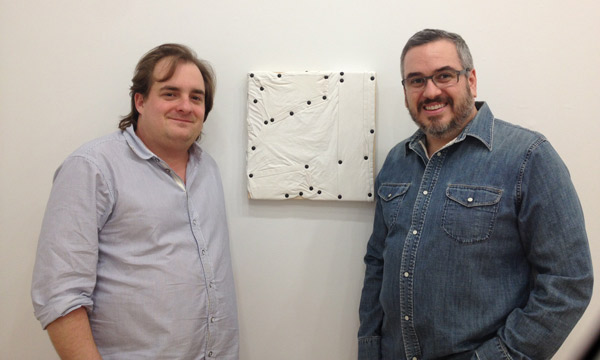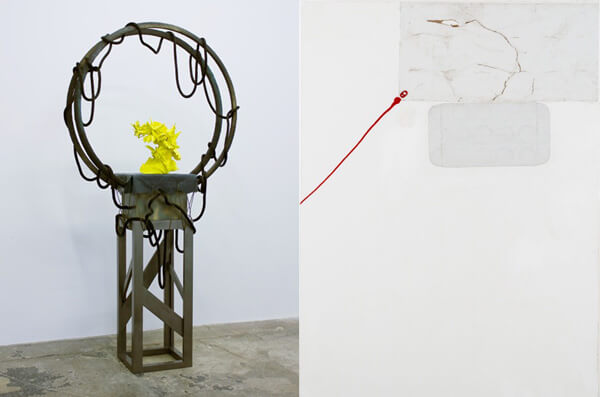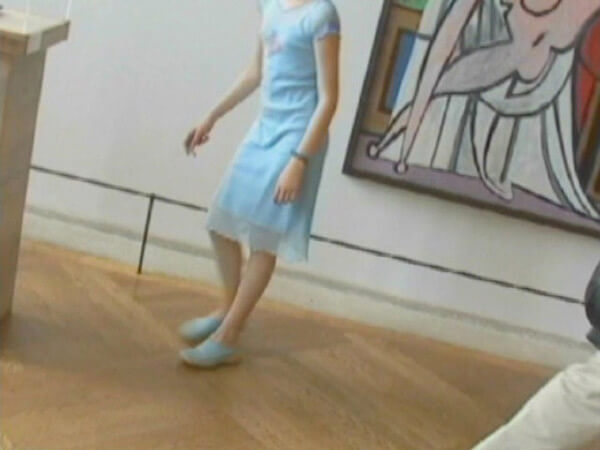Scott J. Hunter is a modern renaissance man. Raised in a musical family, he majored in science in college, but continued avidly singing contemporary repertoire. A pediatric neuropsychologist in clinical practice and on the faculty at the University of Chicago, he is also an energetic advocate of the contemporary music and art scenes in Chicago. He serves on the board of the International Contemporary Ensemble (ICE) and as VP and Chair of Programming for the Society for Contemporary Art at the Art Institute of Chicago. Scott has an enviable art collection of diverse works. Many reflect “being on the outside,” related to gender, race, and status. He debuts his first curated gallery exhibition PSYCHOSEXUAL: An exploration of the abstracted gesture at the Andrew Rafacz Gallery in Chicago, April 6 – May 25, 2013.
Your exhibit focuses on “gesture” in art; how does “gesture” tie visual and musical art together?
The gesture in visual art and music is quite captivating. In art, this is an action or response across mediums which reflects the artist’s emotional or psychological state. The gesture may be something small–a simple direct brushstroke–that is both evocative and referential. It may be the broader actions taken by the sculptor where each touch, each fingerprint, serves to unleash a response.
Similarly, the gesture is a referential element in music. When the composer identifies, and records on the score, a tonal relationship or set of phrases that evoke a mood or idea, he or she is offering a gesture that is then considered and interpreted by the performers. A wonderful example of this is Marcos Balter’s Descent from Parnassus, composed for flutist Claire Chase. Inspired by Cy Twombly’s work of the same name, it interweaves vocal and tonal gestures, evoking a progression across time and space. Moments within the piece radiate emotion–sadness, anger, fear–much as each gesture in Twombly’s painting guides the viewer down a multilayered path.

Scott Hunter (right) and Andrew Rafacz with Tom Burr’s “his personal effects (white, six)”, 2012 (courtesy of the artist and Bortolami Gallery, NY)
What will your PSYCHOSEXUAL exhibition feature?
It explores the relationships between artists and viewers, as they are mediated within the gallery by the objects the artists have produced. The title Psychosexual provides framing, highlighting that the work of each artist represents highly personal, even unconscious concerns, derived from early impulses and experiences that are still being psychologically digested. Each piece in the exhibition is a device by which the artist engages the viewer in a dialog about self, ideas, and emotions that are evoked. The exhibition is therefore about potential relationships and their emergent dialogs.
I selected the works to facilitate this dialog, both individually, and collectively. We have three video pieces (by Jayson Keeling, Lutz Bacher, and Kirsten Stoltmann), three sculptures (by Edmund Chia, Rachel Niffenegger, and Jeffry Mitchell), and seven two-dimensional works, including painting and photography (by Jutta Koether, Tom Burr, John Neff, Matthias Dornfeld, Nazafarin Lotfi, Brenna Youngblood, and Peter Otto). These are all artists early to mid-point in their careers, who are examining concerns of the present through a broader personal lens. The works by Burr and Koether are components of their broader practices, but are also unique in their explorations of psychological space. The videos each explore the vicissitudes of relationships, whether solely through a personal framework, or within a broader social construct. The sculptures are each unique in their reflection of both the personal and the embodied erotic, directly considering the emerging social and sexual self. The 2D works each consider the relationship between a personal self and an inquisitive other, ranging from spare in their evocation of ideas, like the Youngblood painting, to more clearly psychological.

Left: Edmund Chia, Untitled, 2013 (courtesy of the artist) Right: Brenna Youngblood, Untitled, 2012 (courtesy of the artist, Honor Fraser Gallery, Los Angeles, and a private collector)
What is your personal art collection aesthetic?
My visual art collection aims to create a dialog and engage in an active relationship with what I interpret is at the heart of each artist’s efforts. And this reflects my own current considerations, aesthetically as well as psychologically. I curate my personal space with pieces that set up a dialectic to enrich my own daily experience, while also challenging my notions about what is engaging and meaningful. I have a strong affinity for work by emerging to middle-career contemporary artists with a connection to Chicago. I am most interested in work that is abstract and plastic; art that uses materials and a variety of media to convey an understanding of a specific personal consideration or reference.
When I listen to music, I often find visual images forming in my imagination, guiding how I engage with and understand a piece. I often listen with my eyes closed, allowing these sometimes vivid, sometimes fleeting images to form and retreat. I gravitate towards music that is highly abstract in construction, utilizing a combination of instruments and sounds to define a specific environment. Phyllis Chen’s compositions for ICE are a wonderful example. Similarly, I am fascinated by works of Kaija Saariaho and Nico Muhly, as they tonally redefine space and time.
How does your board service with ICE reflect your musical interests?
I devote a lot of energy working with ICE to help build a contemporary music community that is engaged in performance and education. But I am not monolithic in my musical considerations. I subscribe to the Chicago Symphony’s contemporary MusicNOW series and attend many Lyric Opera and Chicago Opera Theatre performances–vocal performance remains a true love. I have broad interests; I grew up listening to classical, rock, and country, reflecting my parent’s varied tastes. I came of age with punk and new wave, and am still drawn to experimental music. And, yes, I like to sing along to the car radio–loudly and enthusiastically.

Lutz Bacher, video still from Girl in a Blue Dress, 2002 (courtesy of the artist and Ratio 3 Gallery, San Francisco)
Why are you and Andrew Rafacz developing a soundtrack to accompany PSYCHOSEXUAL?
Andrew and I share a deep love for music; it is one thing that drew us together as friends. We want to accompany the exhibition with a soundscape–works across multiple genres that compliment and engage with the visual art. Andrew is a major jazz fan with an extensive collection of vinyl records. We are currently working on the final mix for the soundtrack–considering works from luminaries like Ornette Coleman and Abbey Lincoln, to more clearly Chicago-affiliated performers like Terry Callier and Patricia Barber. We want to present challenging contemporary music that will interact with what I am sure will be seen as challenging visual works in the exhibition.
–
Arlene and Larry Dunn are pure amateurs of contemporary music. Visit their blog at Acornometrics and follow them on Twitter: @ICEfansArleneLD.






















